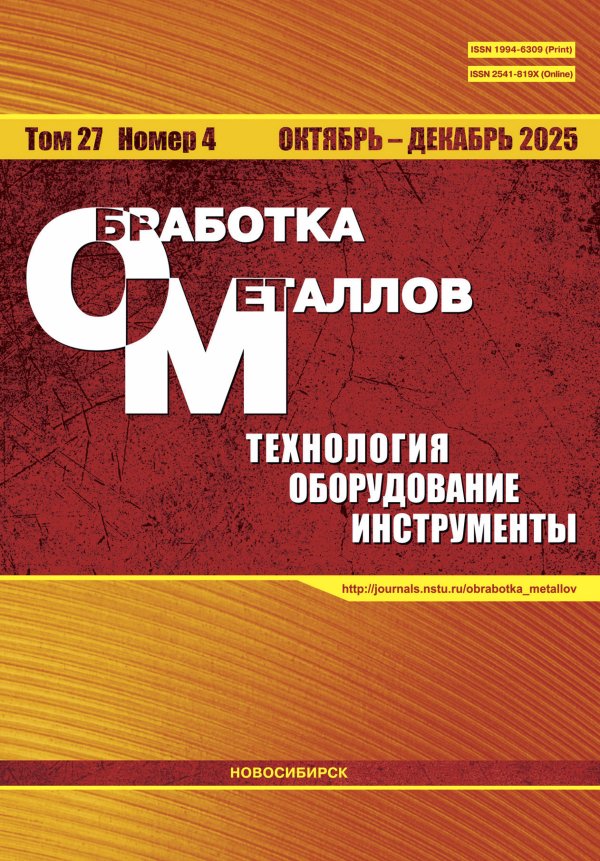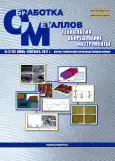АНАЛИЗ, МОДЕЛИРОВАНИЕ И ПРОГНОЗИРОВАНИЕ ШЕРОХОВАТОСТИ ПОВЕРХНОСТИ МЕДИ, ПОЛУЧЕННОЙ МЕТОДОМ СЕЛЕКТИВНОГО ЛАЗЕРНОГО ПЛАВЛЕНИЯ
- Авторы: Сапрыкина Н.А.1
-
Учреждения:
- Юргинский технологический институт (филиал) Национального исследовательского Томского политехнического университета
- Выпуск: № 3 (2017)
- Страницы: 6-16
- Раздел: ТЕХНОЛОГИЯ
- URL: https://bakhtiniada.ru/1994-6309/article/view/302106
- DOI: https://doi.org/10.17212/1994-6309-2017-3-6-16
- ID: 302106
Цитировать
Полный текст
Аннотация
Об авторах
Наталья Анатольевна Сапрыкина
Юргинский технологический институт (филиал) Национального исследовательского Томского политехнического университета
Email: nat_anat_sapr@mail.ru
ул. Ленинградская, 26, г. Юрга, 652055, Россия
Список литературы
- Beaman J.J., Deckard C.R. Selective laser sintering with assisted powder handling: patent 4938816 US. - Appl. date 03.07.1990.
- Шишковский И.B. Селективное лазерное спекание и синтез функциональных структур: дис. … д-ра физ.-мат. наук: 01.04.17. - Самара, 2006. - 390 с.
- Direct selective laser sintering of metals / M. Agarwala, D. Bourell, J. Beaman, H. Marcus, J. Barlow // Rapid Prototyping Journal. - 1995. - Vol. 1, iss. 1. - P. 26-36. - doi: 10.1108/13552549510078113.
- Mumtaz K., Hopkinson N. Top surface and side roughness of Inconel 625 parts processed using selective laser melting // Rapid Prototyping Journal. - 2009. - Vol. 15, iss. 2. - P. 96-103. - doi: 10.1108/13552540910943397.
- Integrative production technology for high-wage countries / ed. by C. Brecher. - Berlin: Springer-Verlag Berlin Heidelberg, 2012. - 1096 p. - ISBN 978-3-642-21066-2. - doi: 10.1007/978-3-642-21067-9.
- Gibson I., Rosen D.W., Stucker B. Additive manufacturing technologies: rapid prototyping to direct digital manufacturing. - New York, USA: Springer, 2009. - 459 p. - ISBN-10: 1441911197. - ISBN-13: 9781441911193.
- Theoretical and experimental study on surface roughness of 316L stainless steel metal parts obtained through selective laser melting / D. Wang, Y. Liu, Y. Yang, D. Xiao // Rapid Prototyping Journal. - 2016. - Vol. 22, iss. 4. - P. 706-716. - doi: 10.1108/RPJ-06-2015-0078.
- Cheng B., Shrestha S., Chou K. Stress and deformation evaluations of scanning strategy effect in selective laser melting // Additive Manufacturing. - 2016. - Vol. 12, pt. B. - P. 240-251. - doi: /10.1016/j.addma.2016.05.007.
- Influences of processing parameters on surface roughness of Hastelloy X produced by selective laser melting / Y. Tian, D. Tomus, P. Rometsch, X. Wu // Additive Manufacturing. - 2017. - Vol. 13. - P. 103-112. - doi: 10.1016/j.addma.2016.10.010.
- Lasers and materials in selective laser sintering / J. Kruth, X. Wang, T. Laoui, L. Froyen // Assembly Automation. - 2003. - Vol. 23, iss. 4. - P. 357-371. - doi: 10.1108/01445150310698652.
- Jhabvala J., Boillat E., Glardon R. Study of the inter-particle necks in selective laser sintering // Rapid Prototyping Journal. - 2013. - Vol. 19, iss. 2. - P. 111-117. - doi: 10.1108/13552541311302969.
- Selective laser melting of iron-based powder / J.P. Kruth, L. Froyen, J. Van Vaerenbergh, P. Mercelis, M. Rombouts, B. Lauwers // Journal of Materials Processing Technology. - 2004. - Vol. 149, iss. 1-3. - P. 616-622. - doi: 10.1016/j.jmatprotec.2003.11.051.
- Saprykin A.A., Saprykina N.A. Engineering support for improving quality of layer-by-layer laser sintering // Proceedings - 2012 7th International Forum on Strategic Technology, IFOST 2012, Tomsk, 18-21 September 2012. - Tomsk, 2012. - P. 6357719. - doi: 10.1109/IFOST.2012.6357719.
- Improvement of the sintered surface and bulk of the product via differentiating laser sintering (melting) modes / N.A. Saprykina, A.A. Saprykin, D.A. Arkhipova, I.F. Borovikov // IOP Conference Series: Materials Science and Engineering. - 2016. - Vol. 142, N 1. - P. 012089. - doi: 10.1088/1757-899X/142/1/012089.
- Спиридонов А.А. Планирование эксперимента при исследовании технологических процессов. - М.: Машиностроение, 1981. - 184 c.
Дополнительные файлы







